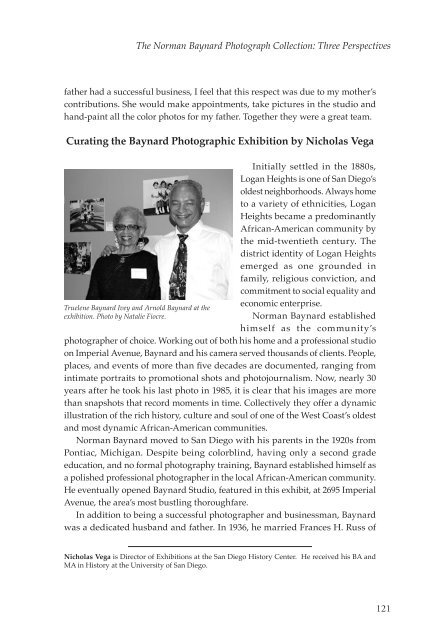Summer 2011, Volume 57, Number 3 - San Diego History Center
Summer 2011, Volume 57, Number 3 - San Diego History Center
Summer 2011, Volume 57, Number 3 - San Diego History Center
You also want an ePaper? Increase the reach of your titles
YUMPU automatically turns print PDFs into web optimized ePapers that Google loves.
The Norman Baynard Photograph Collection: Three Perspectives<br />
father had a successful business, I feel that this respect was due to my mother’s<br />
contributions. She would make appointments, take pictures in the studio and<br />
hand-paint all the color photos for my father. Together they were a great team.<br />
Curating the Baynard Photographic Exhibition by Nicholas Vega<br />
Truelene Baynard Ivey and Arnold Baynard at the<br />
exhibition. Photo by Natalie Fiocre.<br />
Initially settled in the 1880s,<br />
Logan Heights is one of <strong>San</strong> <strong>Diego</strong>’s<br />
oldest neighborhoods. Always home<br />
to a variety of ethnicities, Logan<br />
Heights became a predominantly<br />
African-American community by<br />
the mid-twentieth century. The<br />
district identity of Logan Heights<br />
emerged as one grounded in<br />
family, religious conviction, and<br />
commitment to social equality and<br />
economic enterprise.<br />
Norman Baynard established<br />
himself as the community’s<br />
photographer of choice. Working out of both his home and a professional studio<br />
on Imperial Avenue, Baynard and his camera served thousands of clients. People,<br />
places, and events of more than five decades are documented, ranging from<br />
intimate portraits to promotional shots and photojournalism. Now, nearly 30<br />
years after he took his last photo in 1985, it is clear that his images are more<br />
than snapshots that record moments in time. Collectively they offer a dynamic<br />
illustration of the rich history, culture and soul of one of the West Coast’s oldest<br />
and most dynamic African-American communities.<br />
Norman Baynard moved to <strong>San</strong> <strong>Diego</strong> with his parents in the 1920s from<br />
Pontiac, Michigan. Despite being colorblind, having only a second grade<br />
education, and no formal photography training, Baynard established himself as<br />
a polished professional photographer in the local African-American community.<br />
He eventually opened Baynard Studio, featured in this exhibit, at 2695 Imperial<br />
Avenue, the area’s most bustling thoroughfare.<br />
In addition to being a successful photographer and businessman, Baynard<br />
was a dedicated husband and father. In 1936, he married Frances H. Russ of<br />
Nicholas Vega is Director of Exhibitions at the <strong>San</strong> <strong>Diego</strong> <strong>History</strong> <strong>Center</strong>. He received his BA and<br />
MA in <strong>History</strong> at the University of <strong>San</strong> <strong>Diego</strong>.<br />
121







![[PDF] The Journal of San Diego History Vol 52: Nos 1 & 2](https://img.yumpu.com/25984149/1/172x260/pdf-the-journal-of-san-diego-history-vol-52-nos-1-2.jpg?quality=85)

![[PDF] The Journal of San Diego History - San Diego History Center](https://img.yumpu.com/25984131/1/172x260/pdf-the-journal-of-san-diego-history-san-diego-history-center.jpg?quality=85)







